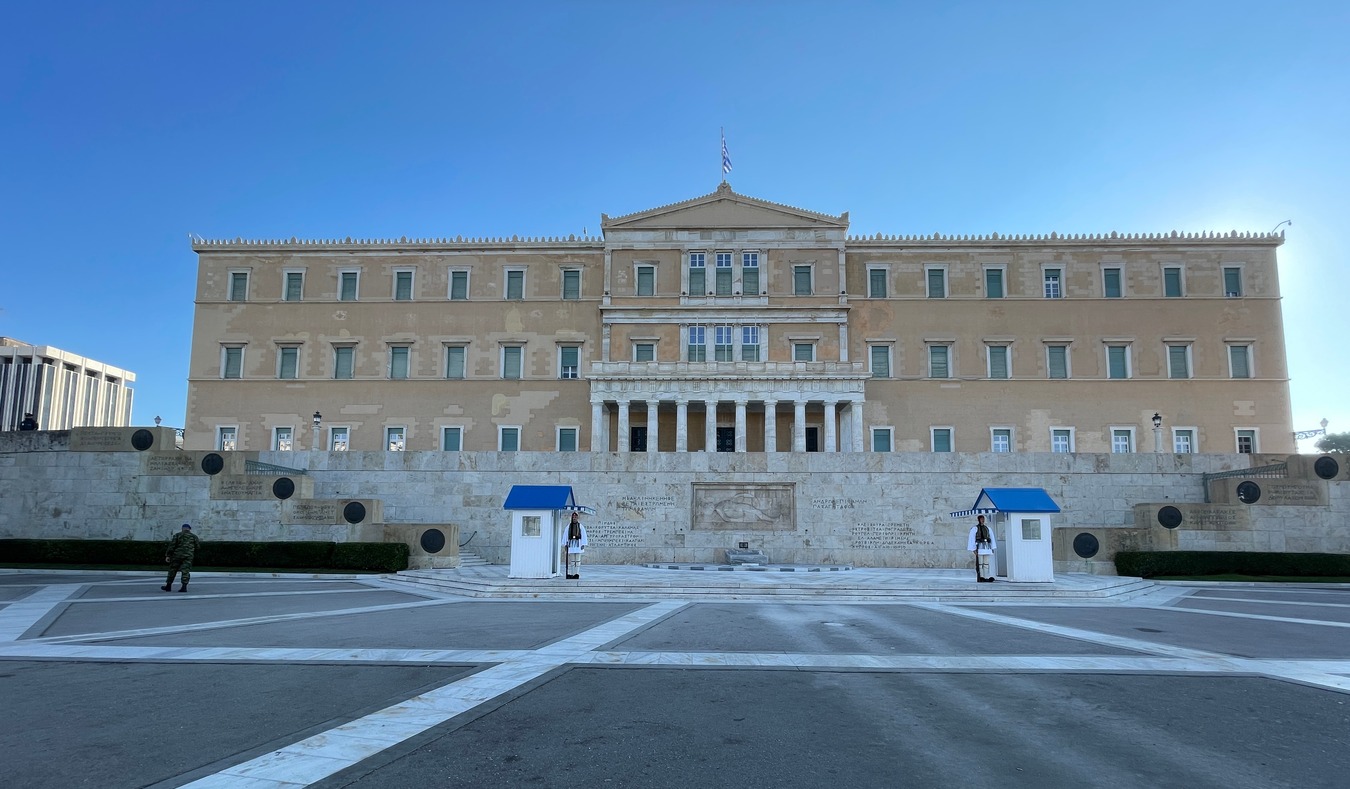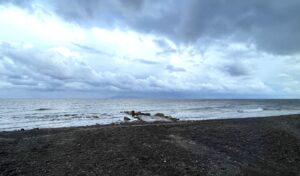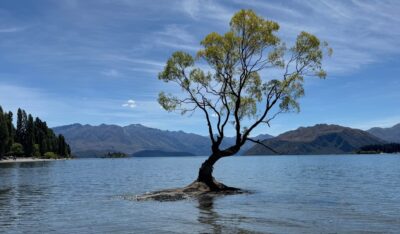Highlights of the Day
Today, we explored Athens, starting at Syntagma Square and watching the Presidential Guards’s changing ceremony. We visited the National Garden and the Temple of Olympian Zeus, when only 15 columns remain. Hadrian’s Arch and Plaka’s charming streets followed. For lunch, we enjoyed fresh seafood at a restaurant near Roman Agora. Later, we toured the Ancient Agora and Acropolis Museum, learning about the Caryatids. Our last stop was Socrates‘ Prison, a powerful reminder of his commitment to law. We ended the day with dinner overlooking the Acropolis, where both the food and service were excellent.
Logistics
Accommodation: ATHENS MARRIOTT HOTEL (highly recommended)
Transportation: Public transportation or rideshare
Athens Travel Journal
I have always known that Greece has a long history and ancient philosophers who influenced world civilization. Greek mythology is also world-famous. However, I never seriously studied it. To prepare for this trip, I did some quick learning. I highly recommend Professor Zhao Lin’s video on the rise and fall of ancient Greek civilization, as well as videos by Yuan Tengfei and Shi Guopeng. Rick Steves’ Europe travel app is also useful.
The first stop on this trip is Athens. I was excited to explore ancient Greek civilization.
Today’s Athens tour started at Syntagma Square.
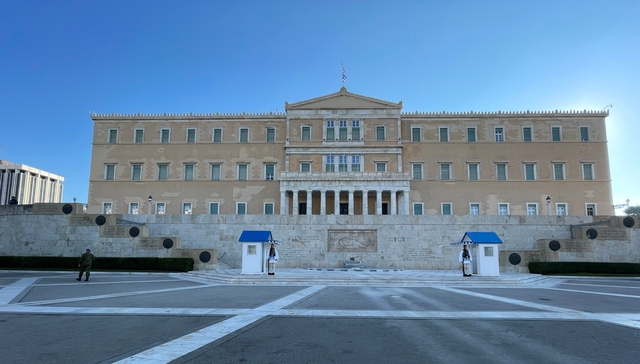
After centuries of Ottoman rule, the Greeks rose in rebellion and fought for independence. In the 1830s, with help from Britain, France, and Russia, they expelled the Ottomans and won their independence. However, they then ended up with a German-born autocratic king, Otto. In 1843, the people of Athens gathered in this square to demand a constitution from him. That’s how it got its name, Constitution Square. At the front of the square stands the Tomb of the Unknown Soldier. Every hour, the Presidential Guard performs a changing of the guard ceremony. We happened to catch the ceremony, making it a perfect moment for photos and videos.
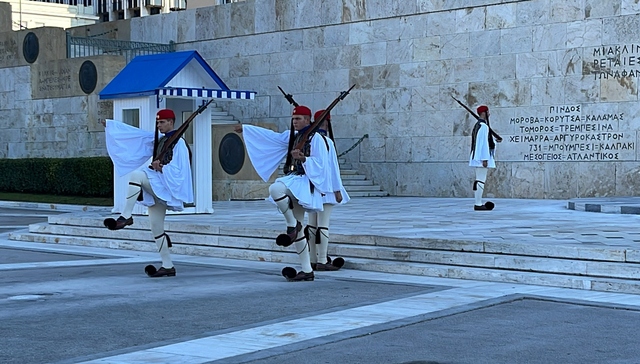
Not far from the square is the open National Garden of Athens. We took a detour to check out the sundial there.
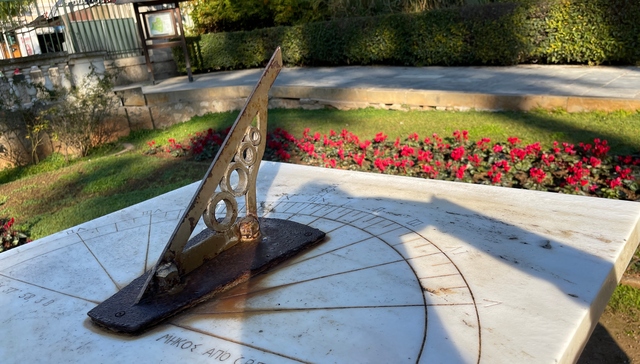
Further ahead is the Temple of Olympian Zeus. Construction started in the 6th century BC, but it took over 600 years to complete. It became Athens’ largest temple and housed one of the largest statues of Zeus. In 86 BC, Roman commander Sulla conquered Athens, dismantled some columns and building materials, and transported them to Rome. To this day, remains of these materials can still be seen in the Roman Forum. The temple was once famous for its ivory and gold statue. Originally, 104 Corinthian columns stood here, but now only 15 remain. Despite this, its former grandeur is still evident. Broken marble pieces scattered around the site provide valuable insight into ancient construction techniques.
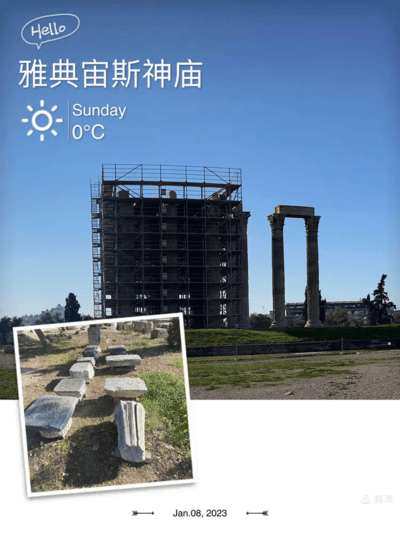
Hadrian’s Arch, built in 131 AD, was erected to honor Roman Emperor Hadrian’s visit. He had donated generously to the city for a newly built temple. The arch remains intact to this day.
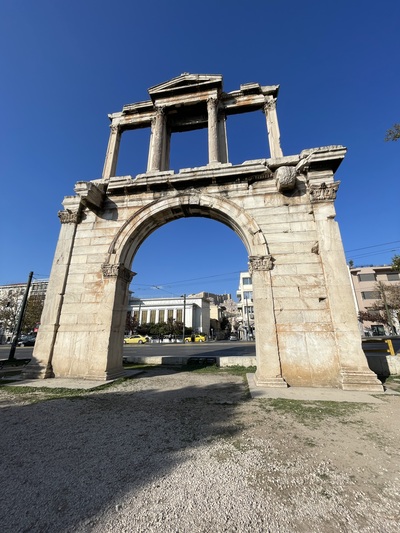
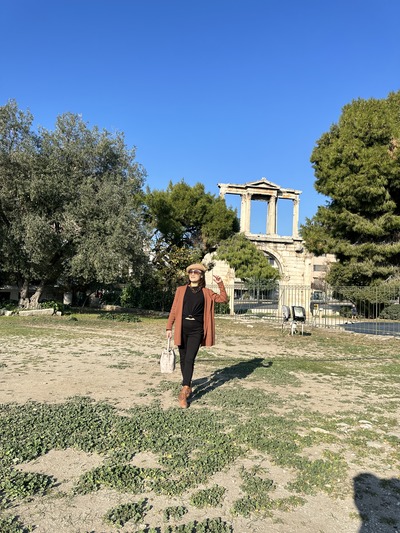
Plaka is Athens’ oldest and most beautiful neighborhood. Today, it’s a shopping and dining paradise. Walking from the Temple of Olympian Zeus to Plaka, the street views reminded us of small streets in Shanghai. It has been over three years since we last visited China—hopefully, this year, we can make the trip back.
Back to our trip. The weather forecast said Greece isn’t cold in January, so we chose to visit. We didn’t expect such a pleasant climate. Strolling along the cobblestone streets of Plaka, the warm sun was comforting. My eyes were busy window-shopping in the little stores. My husband saw a store entrance covered in beautiful climbing flowers and insisted I take a photo. Our younger one pointed out that taking pictures without buying anything might not be polite. In the end, we bought a silk scarf. I thought it was too expensive, but my family was eager to support the store.
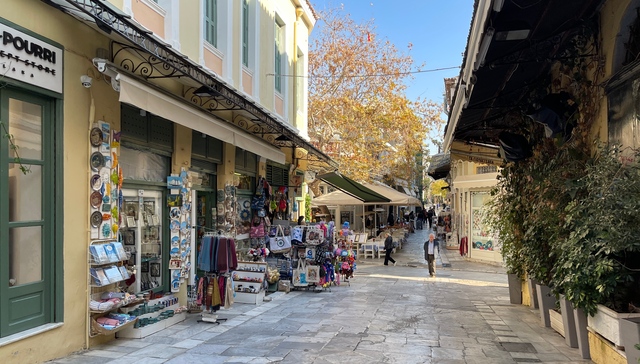
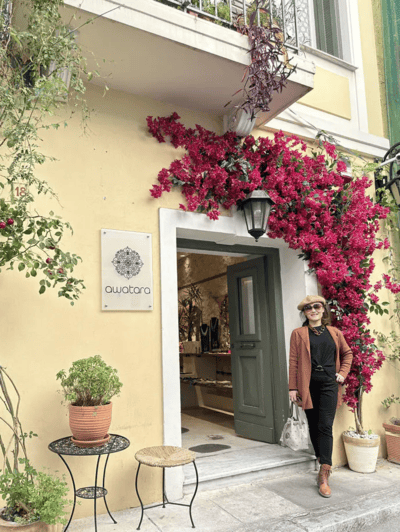
A few minutes from Plaka is the Roman Agora, built between 17-27 BC as part of Julius Caesar’s promise to Athens. The site has not been fully excavated, but records describe it as an open-air structure surrounded by colonnades, with shops, fountains, and toilets. On its eastern side stands the Tower of the Winds, considered the world’s first meteorological station.
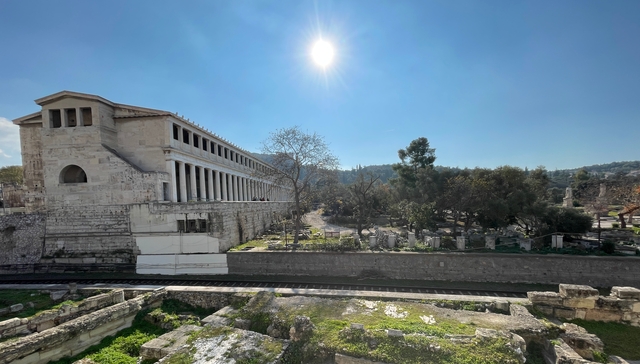
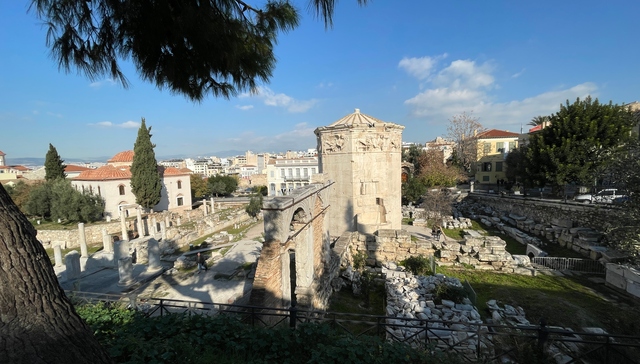
By the time we left the Roman Agora, it was lunchtime. The streets were full of restaurants. My family wanted Greek gyros, but after searching, we couldn’t find any and settled for a seafood restaurant. We didn’t expect much from a tourist area, but the food was surprisingly delicious—fresh ingredients and well-prepared. Highly recommended.
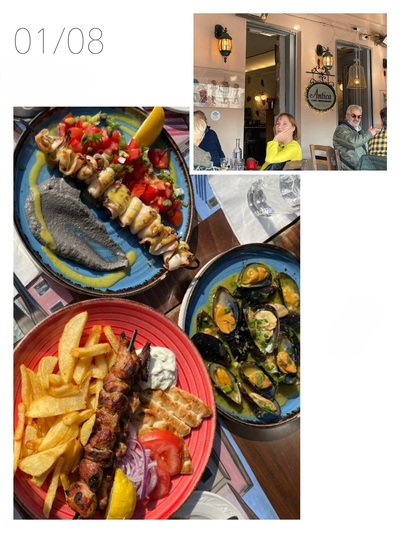
Our first stop after lunch was the Ancient Agora of Athens. Mostly ruins remain, making it hard to picture its original state. Fortunately, the reconstructed Stoa of Attalos, rebuilt in the 1950s, gave us a glimpse into the grandeur of this ancient market.
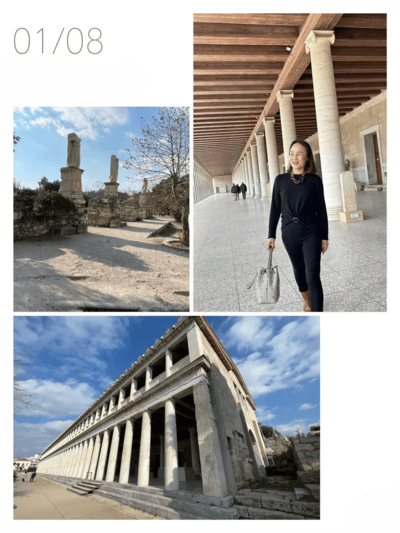
Tomorrow’s highlight is the Acropolis. Today, we visited the Acropolis Museum to prepare. Near the museum, an elderly woman suddenly handed me a rose. Before I could react, she held up ten fingers and said, “10 euros.” We hesitated, so she immediately lowered the price to five. We returned the flower, and she left without causing trouble. As we walked away, a passerby overheard us and told us the actual price was only two euros. It turned out he was from Shanghai. No wonder he understood our conversation.
At the museum entrance, a glass-covered section displayed excavated artifacts. Inside, we saw the original Caryatids from the Erechtheion temple. The ones at the Acropolis are replicas. Only five remain here, as the sixth is in the British Museum. This has been a long-standing dispute. Some say British diplomats had permission from the Greek government to take the artifacts, while others claim they were stolen. The Greek government continues to negotiate for their return.
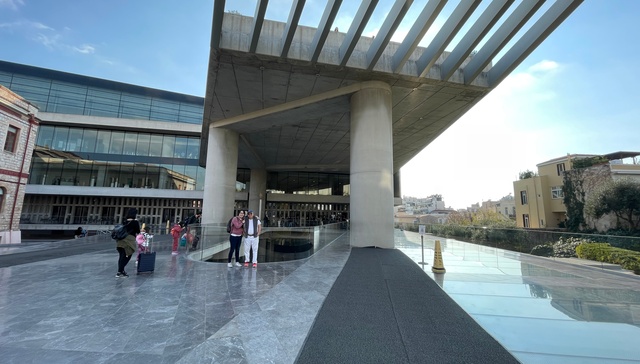
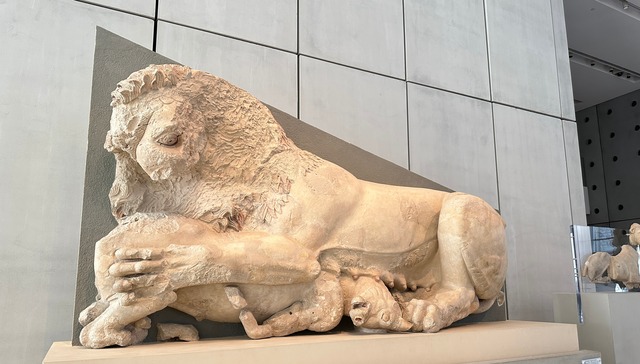
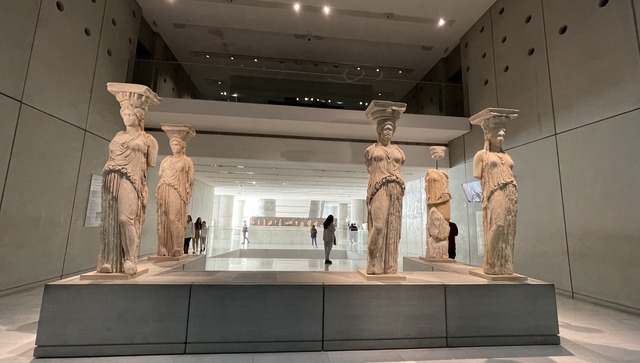
Outside the museum, there was an open-air seating area where we enjoyed coffee and snacks while admiring the Acropolis from a distance. It was a relaxing moment.
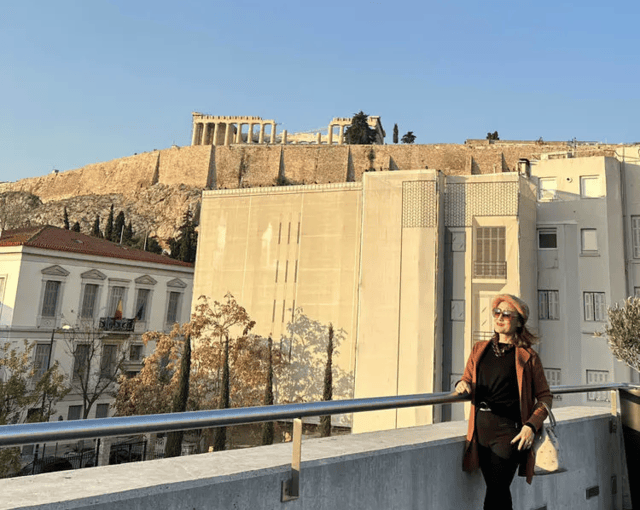
Our last stop for the day was Socrates’ Prison. I had heard about this site in Shi Guopeng’s video, so I didn’t want to miss it. Socrates had the chance to escape but refused. He believed that, despite the false accusations against him, as an Athenian citizen, he must abide by Athenian law. This was his ultimate defense of his beliefs.
After leaving Socrates’ Prison, we encountered a dog charging toward us. Instinctively, we stepped back. Soon, a man casually walked over, holding a leash. I told him his dog almost attacked us. He confidently replied, “My dog is gentle; it won’t attack anyone. If it did, I would keep it leashed from now on.” I thought, “Wouldn’t it be too late by then?” But since we were in a foreign place, I didn’t argue further. This reminded me of an incident yesterday at a New Jersey beach. A police car was parked on the boardwalk, announcing warnings over a loudspeaker. When we asked, we learned someone on the beach had an unleashed dog. After hearing the warning, the owner obediently put the leash on. Even on an empty beach, the rules were enforced.
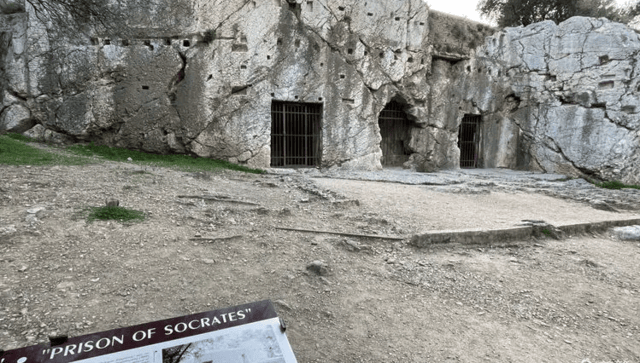
We found a highly recommended restaurant online, famous for its Acropolis night views. The decor was grand, the Acropolis beautifully illuminated across from us, and the food was excellent. The service was also outstanding. Since it was winter, we had to sit indoors, but in summer, the terrace must be even better.
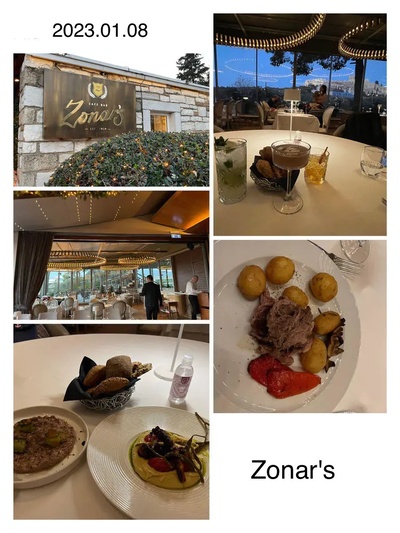
Here is a night view of the Acropolis taken outside the restaurant.
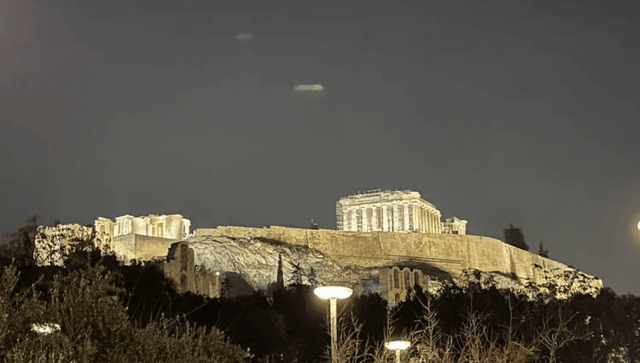
If you’d like to learn more about the itinerary, please click the button below to download a free copy of the customizable itinerary.

